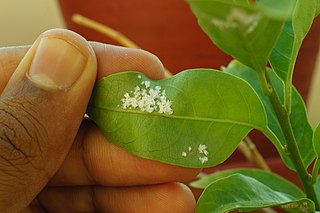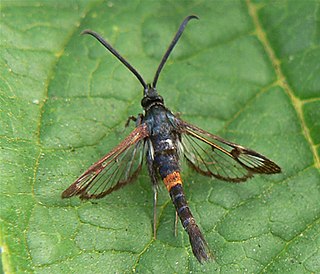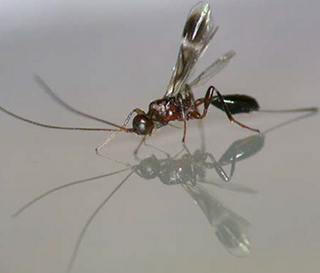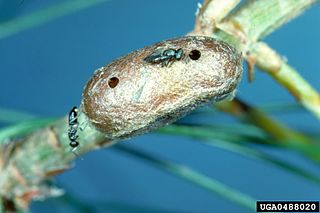
Biological control or biocontrol is a method of controlling pests, whether pest animals such as insects and mites, weeds, or pathogens affecting animals or plants by using other organisms. It relies on predation, parasitism, herbivory, or other natural mechanisms, but typically also involves an active human management role. It can be an important component of integrated pest management (IPM) programs.

The Tachinidae are a large and variable family of true flies within the insect order Diptera, with more than 8,200 known species and many more to be discovered. Over 1,300 species have been described in North America alone. Insects in this family commonly are called tachinid flies or simply tachinids. As far as is known, they all are protelean parasitoids, or occasionally parasites, of arthropods, usually other insects. The family is known from many habitats in all zoogeographical regions and is especially diverse in South America.

Helicoverpa zea, commonly known as the corn earworm, is a species in the family Noctuidae. The larva of the moth Helicoverpa zea is a major agricultural pest. Since it is polyphagous during the larval stage, the species has been given many different common names, including the cotton bollworm and the tomato fruitworm. It also consumes a wide variety of other crops.

Woolly aphids are sap-sucking insects that produce a filamentous waxy white covering which resembles cotton or wool. The adults are winged and move to new locations where they lay egg masses. The nymphs often form large cottony masses on twigs, for protection from predators.

The codling moth is a member of the Lepidopteran family Tortricidae. They are major pests to agricultural crops, mainly fruits such as apples and pears, and a codling moth larva is often called an "apple worm". Because the larvae are not able to feed on leaves, they are highly dependent on fruits as a food source and thus have a significant impact on crops. The caterpillars bore into fruit and stop it from growing, which leads to premature ripening. Various means of control, including chemical, biological, and preventive, have been implemented. This moth has a widespread distribution, being found on six continents. Adaptive behavior such as diapause and multiple generations per breeding season have allowed this moth to persist even during years of bad climatic conditions.

Parasitoid wasps are a large group of hymenopteran superfamilies, with all but the wood wasps (Orussoidea) being in the wasp-waisted Apocrita. As parasitoids, they lay their eggs on or in the bodies of other arthropods, sooner or later causing the death of these hosts. Different species specialise in hosts from different insect orders, most often Lepidoptera, though some select beetles, flies, or bugs; the spider wasps (Pompilidae) exclusively attack spiders. More rarely, parasitoid wasps may use plant seeds as hosts, such as Torymus druparum.

Synanthedon myopaeformis is a moth of the family Sesiidae and the order Lepidoptera. In Europe it is known as the red-belted clearwing and in North America as the apple clearwing moth. The larvae create galleries under the bark of fruit trees, especially old trees with damaged trunks. During this process, the larvae cause significant damage to host trees. Particular attention has been paid to the damage they cause to apple trees. Their status as a pest of apple orchards has led to many research projects aimed at controlling populations of the moth. This moth is native to Europe, the Near East and North Africa. Recently, the moth was introduced into North America, being first detected in Canada in 2005. There are several organisms that threaten the larvae, including parasitoids, nematodes, and bacteria.

Larra bicolor is a parasitoid wasp native to South America. It was introduced into Florida as a biological pest control of invasive mole crickets.

Aphis gossypii is a tiny insect, an aphid ("greenfly") in the superfamily Aphidoidea in the order Hemiptera. It is a true bug and sucks sap from plants. It is a widely distributed pest of a variety of agricultural crops in the families Cucurbitaceae, Rutaceae and Malvaceae. Common names include cotton aphid, melon aphid and melon and cotton aphid.

Cyzenis albicans is a species of fly in the family Tachinidae. A parasitoid, it lays its eggs on leaves of oak, maple, birch and other trees, so that when the leaves are consumed by the larvae of the host winter moth, the eggs hatch inside the larvae. The fly is native to Europe and Asia but has been introduced into North America as a biological control agent of the invasive winter moth.

Spathius agrili is a parasitic non-stinging wasp of family Braconidae which is native to North Asia. It is a parasitoid of the emerald ash borer, an invasive species which has destroyed tens of millions of ash trees in its introduced range in North America. As part of the campaign against the emerald ash borer (EAB), American scientists in conjunction with the Chinese Academy of Forestry began searching in 2003 for its natural enemies in the wild, leading to the discovery of several parasitoid wasp species, including Spathius agrili. S. agrili was discovered in Tianjin, China where it is a prevalent parasitoid of EAB larvae in stands of an introduced ash species, and an endemic ash species. S. agrili has been recorded to attack and kill up to 90 percent of EAB larvae.

Gratiana boliviana is a species of beetle in the leaf beetle family, Chrysomelidae. Its common name is tropical soda apple leaf beetle. It is native to South America, where its distribution includes Argentina, Brazil, and Paraguay. It specializes on tropical soda apple, an invasive plant species. It has been released as an agent of biological pest control against the weedy plant in Florida and other parts of the United States.

Eriosoma lanigerum, the woolly apple aphid, woolly aphid or American blight, is an aphid in the superfamily Aphidoidea in the order Hemiptera. It is a true bug and sucks sap from plants.
Aphidius nigripes is a species of parasitoid wasp in the subfamily Aphidiinae of the family Braconidae. It is the most common parasitoid of the potato aphid Macrosiphum euphorbiae in eastern North America. Many other species of aphids may also serve as hosts.
Anaphes nitens is a species of fairyfly, a chalcid wasp in the family Mymaridae. Native to Australia, it is an egg parasitoid of the gum tree snout beetle, a pest of Eucalyptus trees, and has been used in biological pest control of that species.
Hoplocampa testudinea, the apple sawfly or European apple sawfly, is a species of sawfly in the family Tenthredinidae. It is native to Europe but has been accidentally introduced into North America where it became invasive. The larvae feed inside the developing fruits of the apple tree.
Lathrolestes ensator is a species of wasp in the family Ichneumonidae. it is a parasitoid of the apple sawfly Hoplocampa testudinea. Both insects are native to Europe, but the sawfly has been accidentally introduced into North America where it has become established. The larvae of the sawfly tunnel into developing apple fruitlets which later fall to the ground, where the larvae continue their development. The wasp parasitises the larvae and has been released in North America as part of a biological control programme for the sawfly.

Dahlbominus fuscipennis, the sawfly parasitic wasp, is a species of chalcid wasp from the family Eulophidae which parasitizes the European pine sawfly Neodiprion sertifer, among other hosts. It is the only species in the genus Dahlbominus.

Lysiphlebus testaceipes is a species of small braconid parasitoid wasp in the subfamily Aphidiinae. L. testaceipes can utilize numerous species of aphids as hosts and has often been used as a biological control agent against aphid pests. It is considered an invasive species in several European countries.
Bactrocera passiflorae, the Fijian fruit fly, is a species of fly in the family Tephritidae in the insect order Diptera. It is native to several tropical and subtropical islands in the Pacific Ocean and is a pest of fruit crops.















